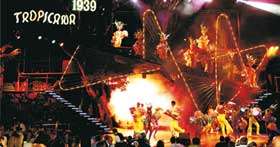The Tropicana is a cabaret, or nightclub, that became internationally famous in the late 1930s. However, it was at its peak in the 1950s, when the club was expanded with new salons and service areas that were built from 1951 to 1954. This work was overseen by Cuban architect Max Borges Recio in collaboration with Spaniard Félix Candela.
As one of the best-known cabarets in the Americas, the Tropicana has changed little over time when compared to similar establishments. In fact, it is probably the only great historic cabaret that still holds outdoor shows.
Initially, the Tropicana opened in an existing building that had been remodeled and enlarged. New architectural elements were added that gave it an unquestionably esthetic value. It was one of the first cabarets whose sole purpose was entertainment, without resorting to the excessive transgressions of moral concepts typical of that period.
The building’s reinforced thin-shell concrete structures can be compared with a series of designs by Italian Pier Luigi Nervi, Spaniard Eduardo Torroja, Brazilian Oscar Niemeyer, and Borges and Candela themselves, who contributed to those architectural elements being recognized as a symbol of American modernity.
With respect to the technology used for the show, it included special effects, fireworks, lighting and stage machinery in the outdoor area, which was called Bajo las Estrellas (“Under the Stars”). Together with lush vegetation, this made up an ideal setting for the choreography of the world-famous Rodney and his followers; not only was the show produced on a horizontal level, it also included acts that until then had been limited to the circus.
The Arcos de Cristal (which means “Glass Arches”) building has concrete vaults joined by sheets of glass that allow people inside the salon to see the trees outside, producing an environment of light and shadows, movement, and above all, the perception of a space where the characteristics of a cabaret are combined with those of its surroundings.
The Tropicana still holds the original sculptures of Cuban artist Rita Longa, which were and continue to be its internationally-recognized symbol.
The nightclub’s structure is in line with the Modern Movement, and at the same time, its function is to provide totally festive leisure, which is fun and trivial without making concessions to bad taste.
From a strictly functional standpoint, the Tropicana is a convergence of the European-style “café cantante” and the cabaret proper with the U.S.-style nightclub, which is why it became an international paradigm: it met the requirements of historic function with the contributions of the most advanced techniques. It can be said that the technology used at the Tropicana was one of the starting points for the use of special effects in music shows.
The Tropicana became a model that would influence significant architectural creations in Mexico, Puerto Rico and other countries in the region, some of them by the same architects.
In Cuba, the Tropicana is directly and concretely associated with culture, especially popular music of the 1950s, when it was regionally important as a point of convergence in the Americas. Today, that scope has become universal, because it is the place where Cuban music was projected to the world, and where a significant number of artists from other countries became international stars by performing on its stages.
Declared a national monument in 2002, the Tropicana continues operating in a way very similar to its early days.










